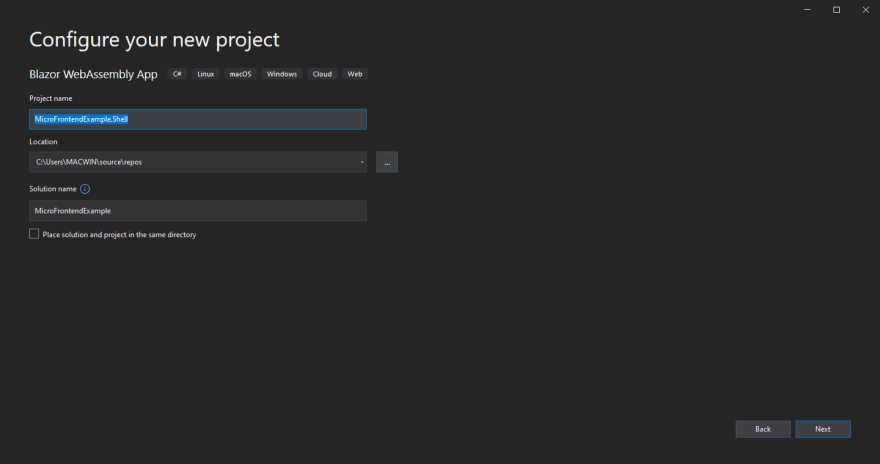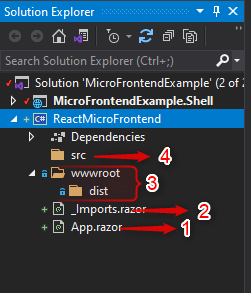This content originally appeared on DEV Community and was authored by Alexander Selorm Kubi
Preamble
Below is a question from StackOverflow emphasizing the need for this article.
We are in the process of building a Blazor.Net5 server application alongside a number of existing web projects (Blazor, Angular, html etc). We would like the Blazor application to be the only application the users go to and access the other sites from it.
I wanted to create a Blazor…
Table Of Contents
To start with...
Let's begin where every project begins!
- Create a new Blazor Web Assembly app with your choice of name, but in our case,
MicroFrontendsExample. - Name the Project as
MicroFrontendsExample.Shell. Note that this particular project will serve as our app shell. - Maintain the solution name as is:
MicroFrontendsExample. - For this project, we'll use .NET5.0 as the targeted version.
Please note that for this guide, I'll stick to using Visual Studio for the project set up.
With our container app/app shell ready, let's begin adding the individual micro frontends.
Now, the main stuff
Let's start with first adding micro frontends based on other JS frameworks. We'll start with React.js due its popularity. Also, we'll be making use of one major feature of Blazor - JavaScript Interoperability (JsInterOp).
To do this, let's add a new Class Library.
- Right click on the solution > Add > New project
- Search for Class library and select C# class library

- Click 'Next'
On the next screen,
- Enter the name of the Class Library (
ReactMicroFrontendin our case) and click 'Next' - Select .Net5.0 as the version
- Click on 'Create'
Voila! That was easy, right?
Now, onto the good stuff - Setting up the React Micro Frontend. Yay!🙏🏽
Since we're working with Blazor, it basically means that we won't be making use of any HTML - only .razor.
I know you're wondering "so where will React's entry point be?" Hold your horses!😀 "do not be afraid", I've got you 😎.
We only need one Blazor component here which will call React's bundled file(s). Don't worry, you'll get what I mean along the line. 😉
Setting things up...
Firstly, let's add the ReactMicroFrontend as a Project Reference to the main Blazor App. This will enable the container app or app shell recognize our class library as a part of itself (in layman's terms).
Do this by:
- Right-clicking on the main Blazor project (
MicroFrontendsExample.Shell) - Select
Add > Project Reference. - In the pop-up window, check the various projects/class libraries that are meant to be your micro frontend applications (
ReactMicroFrontendin our case). - Click OK.
With that being done, let's go ahead and do some more configurations.
Before we can run the Micro Frontend Application, we need to install Microsoft.AspNetCore.Components.Web NuGet package into the Class Library.
Right-click on the class library, select open in terminal. In the opened terminal, enter:
dotnet add package Microsoft.AspNetCore.Components.Web --version 5.0.12
After that, right click on the class library/project, and select Edit Project File.
In the file, add the following modifications:
<!-- add ".Razor" to the Sdk attibute of the <Project> tag, just like below -->
<Project Sdk="Microsoft.NET.Sdk.Razor">
...
<!-- Add the block below -->
<ItemGroup>
<SupportedPlatform Include="browser" />
</ItemGroup>
<!-- -->
...
</Project>
Creating a friendly Folder structure
Let's have a look at how our Class library looks like so far.
From the Solutions Explorer, this is what it looks like:

Now that we've seen how it looks like, let's start with some modifications to make it react friendly.
Setting up a folder structure for your micro frontend is solely dependent on the preferences of the team involved (choice of architecture/principle).
To begin with, let's do some easy stuff! Creating a couple of files and folders.
- Before that, let's delete the
Class1.csfile. - And then, we'll create two(2) files - the entry-point file (
App.razor) and the_Imports.razorfile. - Also, add a new folder named:
wwwroot. - Within the
wwwrootfolder, create another folder calleddist. - Now in the root folder, let's create an
srcfolder.
The
App.razorfile is the entry point of the React Application. It is through this file that the react application is loaded onto the blazor wasm framework.The
_imports.razorfile contains any namespace we'd want available throughout the scope of the Class Library.The ‘wwwroot’ folder contains a ‘dist’ folder where the bundled react app is placed after the react app is built with ‘npm run build’.
The ‘src’ folder is where the react application/codebase resides.
Let's take a break here
In following parts of this series about Micro Frontends in .NET Blazor WASM, I'll delve deeper into the setting up of React.js in the new Class Library we created.
Stay Tuned! Cheers!!!
This content originally appeared on DEV Community and was authored by Alexander Selorm Kubi
Alexander Selorm Kubi | Sciencx (2021-12-11T15:47:57+00:00) Implementing Micro Frontends using .NET Blazor WASM. Retrieved from https://www.scien.cx/2021/12/11/implementing-micro-frontends-using-net-blazor-wasm/
Please log in to upload a file.
There are no updates yet.
Click the Upload button above to add an update.





